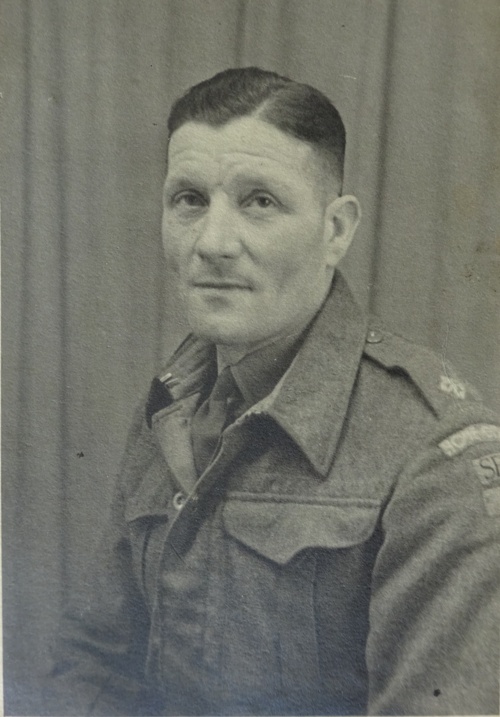
Alfred William Tye in Home Guard Uniform
Alfred William Tye was born at New Houghton, Derbyshire on the 8th February 1903 to William Alfred Tye [1878-1964] and his wife Alice White [1884-1944]. William had been born at Denham near to Hoxne, Suffolk and had worked on the local farms until he decided to go to Derbyshire to work as a coalminer at the Pleasley Colliery in 1901. In 1902 he was married to Alice White a children’s nurse who was the daughter of William Henry and Caroline Hallam.
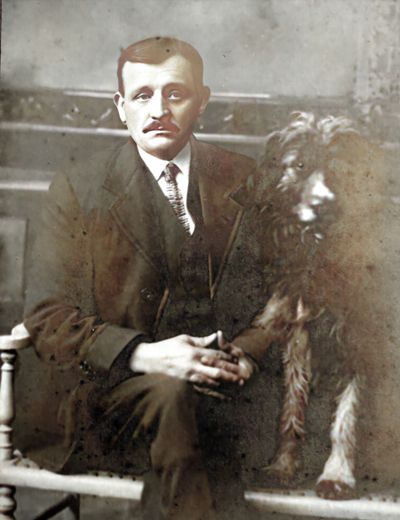
William Alfred Tye with his dog
Alfred was the eldest son being followed by Cyril William in 1905, Leonard Aubrey in 1906 and Shadrach in 1907. By 1909 the marriage of William and Alice was failing so it was decided to send Alfred and Cyril to live with their grandmother Jane Tye [nee Larter] [1844-1929] who lived at Reading Green, Hoxne. Jane was married to Alfred Tye [1837-1897] at Hoxne in 1864.
Leonard stayed with his mother and Shadrach was brought up by his uncle Shedrach Tye [1885-1948] and aunt Elsie May [nee Pearton] [1908-1991] who lived in Middlesex. Cyril William Tye [1905-1972] went to live in Australia and was married to Dorothy Elsie Burton [1911-1997] and they were the parents of Edward, Beverly and Pamela.
Alfred was educated at Hoxne School until he was 14 and then worked for Caleb Last as an agricultural worker at Thorpe Hall Farm. Here he learnt to work with horses which he had a deep affinity with.
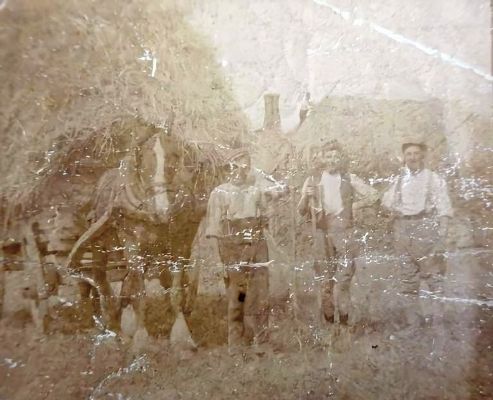
Alfred Tye in middle with Thorpe Hall in the background
In 1923 on the 5th of April he went to Norwich and enlisted into the army as a Hussar. His regiment was the 15th/19th The King’s Hussars who were based at Shorncliffe, Kent. From the 5th April until the 10th January 1924, Alfred was being trained and decided to become a horseman and at the same time gained an army education. His training included a period of time at Tidworth [Salisbury Plain], Wiltshire for a few months. By 1926 he had passed a trade test to become a farrier [class 3] and then a trade test [class 2] in 1928.
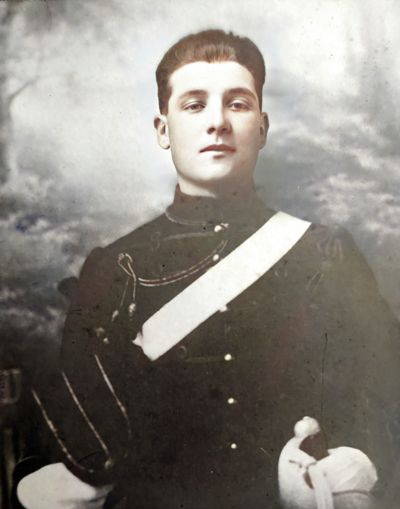
Alfred William Tye in Hussars uniform
From the 11th January 1924 Alfred was stationed in Egypt and stayed here until the 20th October 1928 having spent 4 years and 283 days abroad. His new posting was to be in India at Risalpur under the command of Major J W Francis and he was stationed here from 1928 until the 6th February 1934 having served 5 years and 109 days in India. On the 1st September 1929 Alfred gained the rank of Farrier Corporal. Alfred looked after the Polo ponies and travelled with the regimental Polo team who visited the palaces of the Indian princes and Maharajah’s to play Polo. In 1929 Alfred had passed his trade test [class 1] as a farrier on the 28th May 1929. In 1930 he had 6 months leave and returned home to Hoxne, Suffolk and on the 30th April 1930 was married at Hoxne to Olive Maud Gilman [1903-1996]. Olive was the daughter of Arthur Gilman and his second wife Florence Butcher. Olive had been educated at Hoxne and gained a scholarship to Eye Grammar School. She then trained as an assistant teacher at Hoxne before gaining a teaching position at Worlingworth and later at Wingfield.
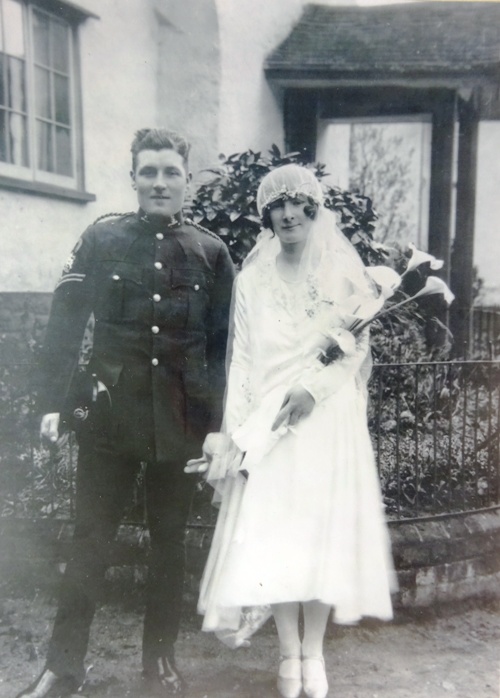
Alfred William Tye and Olive Maud Gilman married at Hoxne in 1930
After marrying at Hoxne, Alfred returned to his regiment in India and from the 12th January until the 20th February 1931 was at the Ambala Veterinary School learning about veterinary first aid and animal hygiene. In 1930 Alfred and Olive became parents with the arrival of a daughter Freda Muriel on the 22nd December.
During his time in India Alfred became the Army welterweight boxing champion and stayed in India until the 6th February 1934 having served 5 years and 109 days abroad. In February 1934 Alfred was posted to the regimental headquarters at Shorncliffe, Kent and stayed here until the 4th April 1935. Alfred had not seen his daughter Freda so had returned home to see his wife and daughter who were living at Hoxne. It was decided that Olive and Freda would go to Shorncliffe to live in the regimental barracks, but Olive decided that after 3 months the life of an army soldier’s wife was not for her.
After 1 year and 57 days at Shorncliffe, Alfred resigned his post in the army and came to Suffolk to live at Hoxne. His military conduct was classified as exemplary and was a very excellent type, most industrious, conscientious and reliable. He was very good at his trade, fond of games and had some knowledge of motor mechanics. In 1935 Alfred gained a job as a driver/mechanic for the Eastern Counties Bus Company and was based at Eye, Suffolk. He drove from Eye to Diss and also to Ipswich and on bus excursions. Alfred worked for the Eastern Counties Bus Company for 35 years before he retired in 1970.
His daughter Freda Muriel Tye [1930-1982] went to Eye Grammar School and was a good sportswoman playing, hockey, netball and tennis along with being a talented artist and embroiderer. After leaving School in 1946 she went to Ipswich Art School and afterwards gained employment with the Cooperative Society in Ipswich as a designer and window dresser for their main shop. In 1950 she was married to James Henry Govier [1910-1974] the art and woodwork master at Eye Grammar School from 1947.
Alfred and Olive lived at Courthouse Cottage in Low Street and he was actively involved in forming a boxing Club at St Edmund’s Hall before the 2nd World War. During the 2nd World War he joined the Hoxne Home Guard as a lieutenant. Alfred played cricket for Hoxne and was a member of the Hoxne Swan Bowling Club and won a number of regional and county trophies and cups which were proudly displayed on the sideboard in the cottage at Hoxne. He was also an active member of the Hoxne branch of the Royal British Legion for more than 40 years. Alfred was a hardworking person and after retiring from driving farmed at South Green with Frank Knights, rearing beef cattle. He enjoyed his life and was a well-respected member of the village. He died at Ipswich Hospital in February 1982 aged 78 just a few months before the death of his only daughter and was buried at Hoxne Church, near to his father.
Article and Pictures provided by Stephen Govier